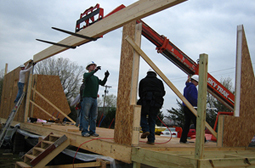K-STATE STUDENTS BUILDING HOUSE THAT RELIES SOLELY ON SOLAR POWER FOR NATIONAL CONTEST
by Erinn Barcomb-Peterson
A group of Kansas State University students have shown that an environmentally friendly house can feel like home.
 The special house the K-State group built was for the 2007 Solar Decathlon, an international competition that challenged university-based teams to design and construct a two-person home powered exclusively by the sun.
The special house the K-State group built was for the 2007 Solar Decathlon, an international competition that challenged university-based teams to design and construct a two-person home powered exclusively by the sun.
The competition culminated when the house was displayed at the National Mall in Washington, D.C. K-State's proposal was one of 20 chosen to compete.
The house was an interdisciplinary effort at K-State: architecture students designed the structure; landscape architecture students are designing the grounds; interior architecture and product design students are designing the furnishings; and mechanical engineering students are designing the heating, air conditioning and ventilation system.
The 800-square-foot house included solar panels, which powered everything in the house from the water heater to the lights. They were placed on the home's sloping south facade. Solar panels usually are placed on the roof, but Gabbard said placing them on the side not only frees up space for skylights, but it also makes them more visible and serves to educate people about sustainability.
"You can operate a normal house just using solar power," Gabbard said. "The panels produce enough power to do any normal household activities. You can cook, take a shower, wash and dry clothing -- anything."
The competition required teams to generate enough energy to power an electric car, Gabbard said.
The home was furnished Energy Star appliances, including a centrifugal dryer that spins water out of clothes, leaving them 95 percent dry in about two minutes. The house takes advantage of natural light when possible, including the bathroom's light well -- a horizontal window that juts out from the house -- with a reflecting pool underneath to reflect the natural light.
Even the home's construction materials are designed with minimal environmental impact in mind. In lieu of two-by-fours on the exterior of the house, the team is using factory-made panels consisting of polystyrene foam sandwiched between plywood. Gabbard said the material is not only light and energy efficient, but it also comes pre-cut to specifications, eliminating the waste that conventional site-built construction projects generate.
The group also used many recycled and reclaimed materials, including salvaged wood from a demolished barn.
Another mission of the design is to celebrate the Kansas landscape. The group took the state's latitude into consideration when deciding where to place the solar panels for optimum efficiency. Landscape architecture students, working in conjunction with the Land Institute in Salina, specified native perennial plants in their site design to minimize the need for irrigation.
Space and mobility are other hallmarks of the project. With just 800 square feet to work with, Gabbard said the designers looked at space-saving methods like those commonly used in Japan. The features include built-in cabinetry, fold-away dining table and home office, and ample livable outdoor spaces like its 600-square-foot deck.
The house is designed to be moved in one piece, making it not only easier to prepare at the competition, but also more flexible. Because the house provides its own energy supply, Gabbard said such a home could be used in remote places without power.
"Making the house livable is important," said Kelly Moore, a K-State graduate who worked on the project. "We really had to think about comfort. We're creating a modular home that's visually compelling and beautiful but appealing to people from all walks of life."